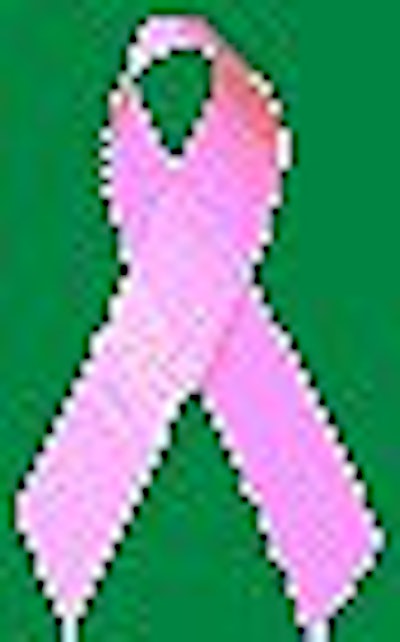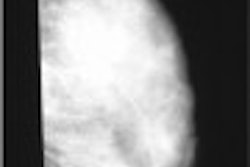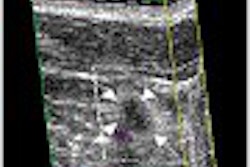
As with any controversial issue, sonographic breast cancer screening has its passionate proponents and its diehard skeptics. For those who have been performing breast ultrasound often and with great success, it’s a no-brainer: Ultrasound has tremendous value in finding cancers in women with dense breasts. For others, personal experience is all well and good, but where is the published evidence from a clinical trial to back up that experience?
If all goes according to plan, the results from a proposed three-year multicenter trial will satisfy both sides. Sponsored by the American College of Radiology Imaging Network (ACRIN), "Screening Breast Ultrasound in High-Risk Women," or ACRIN Protocol A6666, is designed to "provide guidance to patients and practitioners on the role, if any, of (whole-breast) screening breast ultrasound and the associated risk of an unnecessary biopsy."
In the meantime, the debate forges ahead. Below is an excerpt from a roundtable discussion on breast ultrasound held at the 2003 Current Trends in Breast Ultrasound meeting in San Francisco. Participating panel members were:
- Dr. Gilda Cardeñosa of the Breast Center of Greensboro, Greensboro Radiology in Greensboro, NC.
- Dr. Jessica Leung from the University of California, San Francisco.
- Dr. Ellen Mendelson from Northwestern Memorial Hospital, Northwestern University Medical School in Chicago.
- Sonographer Cindy Rapp of Radiology Imaging Associates, Sally Jobe Breast Centre, Greenwood Village, CO.
- Dr. Gary Whitman from the M.D. Anderson Cancer Center in Houston.
Obviously, the panel members were all in favor of breast ultrasound, but they did have some differences of opinion in their approaches, techniques, and thoughts on the value of this promising modality in the fight against breast cancer.
Who should be screened with breast ultrasound?
Mendelson: In our own practice -- within the last eight months or so -- we’ve met with the lead surgeon (and) by her request and our agreement, we are doing bilateral breast ultrasound on patients who have cancer, or who are thought to have a cancer and whose breasts are dense. Sonography has been the best imaging modality to depict that lesion.
So all of those patients are getting bilateral breast ultrasound studies, and we do include the axilla and the nodes. We’ll also (perform breast ultrasound) when requested by patients. But prior to that, we talk to the patient and tell her that there is no indication or support for doing breast ultrasound (alone).
These are patients who are cancer-phobic; they may be young, or are coming because they have a strong family history, particularly those with premenopausal breast cancer in a first-degree relative. Mammography is indicated. Usually, 10 years or so prior to the age at which the diagnosis was made (in the family member), we’ll start with ultrasound. Frequently, these (younger) women are resistant to mammography because of the radiation. But they all end up having mammography as well.
Do you use ultrasound to help alleviate anxiety for young women with unilateral discharge?
Leung: We wouldn’t. Generally, (UCSF policy) is that we don’t do anything that is outside the realm of accepted standards based on published, reviewed literature.
Cardeñosa: I think the important thing is to examine the patient and see if it's multiduct discharge. If you see lots of ducts coming out, then there is no need to do anything more with the patient. If you examine the patient and you have one discharging duct coming straight at you, then what you should consider is ductography rather than ultrasound.
What about a breast ultrasound protocol?
Mendelson: There is no well-established protocol. I usually go quadrant by quadrant, through the breast in overlapping strips so that I know I haven’t missed anything. I go separately to the area posterior to the nipple and up into the axilla. In a breast of average size, it probably takes around 10 minutes to do that.
In the ACRIN trial, we will be checking the time it takes to perform these studies on every ultrasound unit, from the very beginning. We will record that, and everybody (participating in the study) has been advised not to (make small) talk with patients about clothing or jewelry or restaurants, because it will lengthen the scanning time.
Whitman: We basically document each quadrant of each breast, radially or antiradially.
Cardeñosa: I’m doing lots of ultrasound screening. It takes me about 10 minutes to do it. I don’t document unless I see something that I think is a cancer. And yes, you are going to see lots of little nodules that I go right by and don’t document. Again, it’s going to take a lot of training, good units, but let’s stop kidding ourselves. Ultrasound is a phenomenal tool in women with dense tissue.
Just about every woman in my facility who comes in with a mass gets an ultrasound. Do I find (the mass)? Yes. Are they not the same lesions (as on mammography)? Yes. What makes us think that if you find it by ultrasound, it isn’t going to save lives, but if we find it with mammography, it is? Yet those very same people who fought very vigorously for mammography are now putting a stop to (ultrasound).
I would put in a word for common sense. I find it remarkable that the people who are the strongest supporters of mammography, who have looked at every bit of evidence and have thought about the importance of finding small cancers, now all of a sudden, say ‘We can’t do ultrasound! We need evidence to prove that it works!’ What more evidence do we need?
I think it’s insane. I find it extremely hard, when I look at a dense mammogram, to say ‘Next screening mammo in a year.’ Who am I kidding?
Multiple peripheral papillomas and/or multiple benign masses
Cardeñosa: To me, a woman with multiple masses is not excluded from getting a cancer. So I evaluate multiple masses. When you do that with ultrasound, you are going to find multiple papillomas because some of them will be solid, some of them will be cystic masses.
I also monitor cysts and I know the data and literature run counter to me. The patient can have a cancer that’s sitting next to the multiple masses. Certainly when they are smaller masses, I evaluate those patients very carefully with ultrasound. I don’t assume that they are benign just because they are multiple and look similar (to each other).
Leung: In our experience with cancer with multiple masses, we have many caveats; They have to be partially circumscribed, they have to look similar to each other, they can’t be one more dense than the other. It’s not just the generic, clinical multiple mass. Of course, that woman can get a cancer like any other woman.
I have seen cases of cancer among multiple masses that look like those masses. It happens. The question is, how frequently? Our contention is that it’s not very frequent and very infrequent.
In terms of a policy, 2% or less is the standard. I’m not saying that’s the right thing but we have to draw the line somewhere.
Mendelson: I guess we do, but I agree with Gilda. I guess it’s the difference between statistical and individual medicine. The unique is one of the things that we are seeking. Whether or not we have to compromise and practice statistically is something that I wonder.
(On mammography), you say you look at each and every one of them but basically, you kind of gestalt it, and say ‘They all look pretty much the same. Come back next year.’ Should you actually say that, since you have a noninvasive way of evaluating each and every one of those masses? Certainly, with the initial presentation of those women, I do (ultrasound).
Whitman: Anecdotally, in the last year I’ve seen multiple masses that went to sonography and, in a couple of cases, there were cancers that could not be identified mammographically. There is going to be a yield there. At least for me, I feel comfortable doing the sonogram early in their mammographic screening cycle.
Leung: Again, I think it’s all about numbers. There are always unusual exceptions. You have to see in your practice how often this happens and is it worth it? We found that in terms of multiple masses, in our screening population, one out of every 50 cases (is a cancer). Is that a high enough number? I don’t know the answer for that.
How many masses are too many? The legal ramifications
Leung: The more you do, the more you find. Look at the digital mammography studies, comparing digital with screen-film. It was not so much that digital was better than screen-film, it’s that in the patients who had both exams, you were going to find more cancers... you take eight pictures instead of four pictures because of slight projection differences. The more you take, the more you find.
The philosophy of (paying) any cost for (finding) any cancer, I’m not sure that’s realistic. In terms of the lawsuits, one of the reasons that we do studies is to set up a standard reference. At least we’re trying to show with evidence-based medicine what the numbers are.
Cardeñosa: The problem is that the standard of care is now being based on one paper from one institution that most people can never reproduce. I’m actually worried by all the publications I see coming out prematurely with inadequate data that pigeonhole the rest of us.
None of us have the time to do the studies correctly, and the urge to publish now is so great among some people that data is coming out without any sort of follow-up. If you are really going to do a good study, it’s years of follow-up.
I’m very concerned by what I see as the standard of care being developed by one or two papers. The common sense in breast imaging, and the focus on the patient, is really being superseded by all these publications.
Mendelson: Going back to the liability issue, I think the number of cases related to ultrasound (breast imaging) alone has increased markedly. Lawyers do look at our literature. What I see is delayed (diagnoses) or misdiagnoses of breast cancer from not having performed breast ultrasound, or misinterpreting breast ultrasound. More and more, there is an expectation that evaluation of masses goes hand in hand with ultrasound. The standard of care there is evolving.
Excising/biopsying radial scars
Whitman: I think what you may want to do is to discuss it with your pathologist very carefully. Our pathologist is comfortable if it’s a small lesion, where we appear to have taken the whole lesion out, 1 cm or so with vacuum-assisted biopsy and it’s a radial scar with nothing else suspicious. Our pathologist and I feel comfortable with that. If it’s a 2- cm lesion and we don’t completely take out the lesion, or incompletely sample the lesion, then I’m not comfortable and I re-excise.
Mendelson: That sounds like about what we do too. Our pathologists are pretty helpful in saying whether or not the radial scar has been excised completely and giving me the diameter.
Leung: We’re a little more conservative in the sense that if we have a radial scar that is an imaging abnormality on ultrasound or mammography, that would be excised. Radial scars that are detected incidentally -- for example, you core-biopsy something that you suspect is a fibroadenoma. You find the fibroadenoma and there’s another 3-mm focus that’s a radial scar, those we do not excise.
How do you follow-up probably benign mass?
Leung: If the patient is older than 40, our protocol is just one additional exam, because the patient is going to receive screening mammography anyway. There would be a short-term follow-up in the first six months and a bilateral in the next six months, every year after that for a total of three years. But that patient is different because she is now a diagnostic patient instead of a screening patient.
Mendelson: (to Leung) For a probably benign mass or complicated cyst, the inference is that we are dealing with low-level echoes throughout (on ultrasound). We are not dealing with a mass that is partially cystic and partially solid. So at six months follow-up, would you do the sonogram?
Leung: I was only referring to mammographic follow-up for that lesion. For the complex cyst, or the complex cystic mass, we would needle it, either aspiration or core biopsy at the outset.
Mendelson: I might follow it, and if it came back when the patient returned, I would do a sonogram. That’s when you might find that the lesion is gone. You might find that it’s larger, in which case we would aspirate it. If it was the same, we would see her again six months later.
Do you biopsy echogenic masses?
Rapp: With any type of biopsy...it’s important to make sure that you screen through the entire lesion. If you see anything gray inside larger than the size of the duct, then it will go for biopsy.
Whitman: I would agree. If it’s absolute white with nothing hypoechoic, I would not biopsy. But if there’s a small bit of hypoechoic in the center or nearby, then (it would) get biopsied. The echogenic part is most likely a reaction to the mass. If something is palpable, it raises my suspicions.
Wide-footprint transducers, narrow-footprint transducers, and dynamic range
Rapp: When you talk about footprint, is that the 38-mm versus the 50-mm probe? We have the 5-cm (50-mm) probe for breast imaging on our system, and we actually use that for all small parts imaging. Once you get used to it, it’s so hard to go back to a 38-mm probe. It seems to fit pretty much everywhere. If you have a problem, you can use lots of gel for stand off.
(Dynamic range) is something that I rarely change. If you go into the presets the manufacturer has set up, the higher the dynamic range that you use, the more isoechoic your lesions become.
Mendelson: I do adjust (the dynamic range), actually. There are a lot of ways of increasing your grayscale. I do look at dynamic range and it’s very difficult if you are comparing the system of one manufacturer to that of another, to compare dynamic ranges because they (have different names).
There are a number of different mapped presets that are better for breast imaging than others. When you get a unit, I would have an applications person come in so that you can readjust in terms of presets, in terms of the dynamic range, so that you can optimize your breast imaging.
Leung: We really only have the 5-cm footprint. We do have a small -- I don’t even know the number. It looks like a little hockey stick -- that is sometimes is used for guiding interventional procedures to curve around the breast better. But we use the 50-mm for most diagnostic procedures.
Mendelson: That 50-mm probe (is) actually a fantastic transducer and it works for all different settings. The small hockey stick one, which is a curved linear transducer, is a beautiful one for musculoskeletal work and for very superficial lesions. It’s been able to show us details.
US versus MRI -- where does the future of breast imaging lie?
Cardeñosa: I do have this vision that one day we’ll all be doing breast screening with MRI, and breast imaging will be the leading money winner in radiology departments. All of us will be department chairs. Think about it. It could happen.
Mendelson: Certainly we have far less experience with MR than ultrasound. The false-positives, the false-negatives, we really haven’t learned that modality well yet. It’s in its infancy. I think we’d better go with ultrasound first because we have a lot more experience with it, know its limitations, and can use it a whole lot better.
By Shalmali PalAuntMinnie.com staff writer
October 2, 2003
Related Reading
Making the most of breast sonography with the right equipment, techniques, August 25, 2003
Breast US expert reiterates modality’s role as adjunct to mammography, July 11, 2003
Proving breast cancer screening efficacy remains complex, January 10, 2003
Copyright © 2003 AuntMinnie.com



















